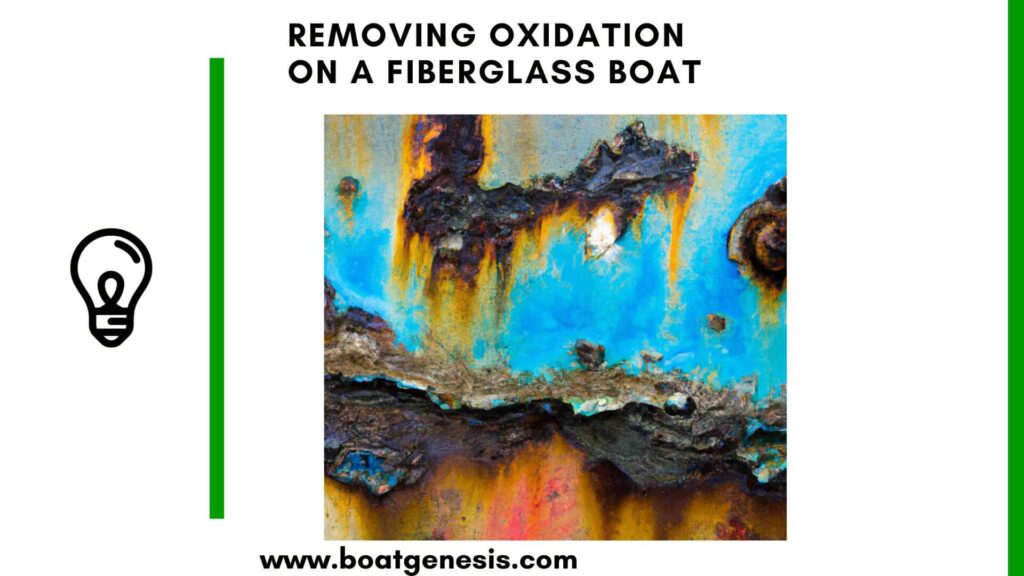Is your once-gleaming fiberglass boat looking a little lackluster? Over time, the sun and elements can cause fiberglass to oxidize, making it appear dull and chalky.
But don’t despair – with some elbow grease and the right products, you can get that shiny finish back.
In this post, we’ll go over what causes oxidation in fiberglass, how to know if your boat needs some revival, and a simple 4-step process to get it looking great using products you likely have at home.
We aim to give you useful advice so you can spend less time scrubbing and more time sailing.
What Causes Fiberglass to Oxidize?
When exposed to UV rays, oxygen, pollution and even saltwater, the gelcoat surface of fiberglass boats can start to break down. The glossy finish starts to look chalky and whitish. This process is called oxidation.
If left alone for too long, the oxidation can start penetrating deeper, causing permanent damage.
The good news is, catching oxidation early and taking some simple removal steps can work wonders.
Inspect Your Boat for Oxidation
Take a good look at that baby from bow to stern.
Do you notice any whitish, chalky areas, especially on surfaces that get the most sun exposure? Do parts look less glossy than others? Use your hand to feel – does the chalkiness come off on your fingers when you touch affected areas?
If so, oxidation is likely building up. The earlier you start removal, the easier the job will be.
Process for Removing Oxidation on a Fiberglass Boat
Here is the best way to remove oxidation on a fiberglass boat:
- Wash and prep the boat. Give the boat a thorough cleaning using a boat soap or mild detergent all over. This removes grime so you can see the true extent of oxidation and prep for the next steps.
- Sand and scuff affected areas. Start with 400 grit sandpaper, sanding gently and evenly across oxidation patches. This scuffs off the top layer of oxidation and gives the next products something to grip.
- Clean sanded areas. Remove all sanding residue with a tack cloth or microfiber towel. Make sure the surface is completely clean before sealing.
- Apply sealant. Use a high-quality boat wax or sealant made for oxidized fiberglass. Apply 2-3 coats, allowing proper drying time between coats to lock in protection.
Some Helpful Tips:
- When sanding, watch the amount of pressure to avoid removing too much gel coat. Start gently and increase pressure as needed.
- Wear a mask so you don’t inhale oxidation dust while sanding.
- If oxidation is extensive, consider a compound like Meguiar’s Heavy Cut Cleaner before sanding to remove the bulk of it with less elbow grease.
- Apply UV protection every season to prevent oxidation’s return. Keep that baby covered or under a canopy when not in use.
Frequently Asked Questions About Boat Fiberglass Oxidation
Oxidation occurs when the gelcoat surface of fiberglass is exposed to harsh elements over time such as sunlight, heat, UV rays, pollution, and even saltwater. The glossy finish starts breaking down and develops a white, chalky, or yellowed appearance.
The areas that get the most direct and prolonged sun exposure are most prone to oxidation. This includes topsides, decks, console tops, radar arches, rail caps, etc. Areas under covers or out of the sun are less likely to oxidize.
Check for visible whitish, chalky spots or areas that have lost their glossy sheen, especially in areas of greater sun exposure. Rub your hand over suspect areas to see if a white residue comes off on your fingers, indicating oxidation. Compare suspect areas to those less exposed to judge color/gloss difference.
At first, oxidation only damages the gelcoat surface layer, acting as a cosmetic eyesore. But if left alone too long, oxidation can penetrate deeper into the fiberglass, causing more expensive repairs and permanent damage. Catching it early is key.
In many cases, yes! If oxidation is only in the early stages and hasn’t penetrated too deeply, using some DIY cleaning, sanding, buffing and sealing techniques can restore the nice glossy finish. But for very heavy, deep oxidation, professional repair may be the best solution.
Read also: Is it easy to repair a fiberglass boat?
Keep your boat out of direct sun whenever possible- use a canvas cover when not in use. Apply a high-quality boat wax 2-3 times per year. Store the boat indoors or under a canopy during winter months. UV reflecting canvas and seat covers also help shield when onboard. Maintaining good cleaning and protection habits early on is your best prevention.
Final Thoughts
We know removing oxidation on a fiberglass boat takes time and effort, but hopefully, these tips make the process a little smoother.
Just think how nice that renewed shine will look out on the water!
Here’s to many more happy voyages with your beauty all spruced up.


